Colorado Medical Society
http://dev.cms.org/articles/2013-spring-conference-report/Cover: Assembly required
Monday, July 01, 2013 11:59 AMWhat physicians need to do to improve the care experience and provide greater value for the premium dollar
Kate Alfano, CMS contributing writer
Editor’s note: The 2013 CMS Spring Conference brought experts from across the country to share their opinions and to dialogue with CMS members on what physicians need to do to improve the patient care experience and to provide greater value for the premium dollar. This extended cover story recaps the presentations and discussions from the conference.
Action steps to transform your practice and thrive in an evolving system
Health care in the United States must change. No longer will anyone dispute that the system is expensive, wasteful and exclusionary and, in some respects, harmful to patients. Physicians’ quality of life has suffered as they have endured increased administrative burden, steep costs and learning curves for new technology, and increased regulations – a patchwork of small answers to a big problem.
 CMS President-elect John Bender, MD, FAAFP, leads the conference.
CMS President-elect John Bender, MD, FAAFP, leads the conference.With the health care system at a breaking point, it is imperative to study and redesign the entire cycle, from preventive medicine to care delivery and from coordination to payment for services, using methods that will move the system closer to the goal of lower costs, increased efficiency and improved value. A group of experts gave physicians action steps for health system reform at the 2013 CMS Spring Conference in Vail, and the record-setting attendance of physicians from around the state validates the demand for these strategies.
As CMS president-elect and conference host John Bender, MD, said: the new reality of reform lives within the framework of the Affordable Care Act, which is the law of the land but still exists largely in statute. He identified five components physicians should consider to thrive in this environment: practice transformation and workflow redesign; team-based care; health information technology and interoperability; metrics reports and population management; and broadening health care access.
Practice transformation and workflow redesign
Bender shared his own story of practice transformation, demonstrating how staff at Miramont Family Medicine in Fort Collins stepped off the proverbial treadmill and improved workflow and processes to improve their quality of care.
In 2002, he and his partners recognized that they were delivering a “lousy” product: “Test results were low, labor costs were high with a lot of non-revenue-generating activity, there were no open appointments, no clinical data management, barely any financial data management and there was high variability in patient experience day-to-day. Documentation was illegible because we were still on paper and I couldn’t compete with retail clinics, urgent care or emergency departments,” Bender said.
They changed their focus after a company retreat in 2007 when they decided that Miramont would offer local families the most convenient and highest value health care that would be delivered in a compassionate, modern and timely way in an environment that promotes patient and staff growth, health and happiness. The practice brought in coaches who examined Miramont’s processes, suggested ways to improve, and gathered data to measure progress and influence the next step.
Bender said his model for success is built on two concepts: continuous improvement and respect for all people. “Continuous improvement can be thought of as never quite being good enough. We make small, continuous, incremental changes and as things get better we’re satisfied for a time but we’re not ever permanently satisfied. We’re always looking for ways to improve.”
Respect for people means trusting team members, encouraging them to take ownership in their part of the process and empowering them to suggest and implement changes to improve the final product, Bender said.
“In 2013, we have five locations in four separate communities; we’re open Monday through Friday 8 to 8, Saturdays 9 to 1; we have 17 providers and 61 employees; we have more than 100 company computers operating in a terminal server environment with 30,000 patients; and in 2010 HiMSS named us the Nicholas E. Davies Award Winner, which acknowledges that we had the best implementation of IT in the U.S. for small, private sector clinics.”
At the same time that Bender was moving his practice forward, 34 primary care physicians in his area left their practices, including eight who went bankrupt. He said the difference comes down to efficiency. “I pay my staff to do in 10 minutes what my competitors are paying theirs to do in 20. When we look back at the practices that bankrupted, they all folded for the same reason: cash flow. If you don’t have cash, you can’t pay your bills. And what was their cash flow problem? Their labor costs.”
All other expenses are “chicken feed” compared to labor, Bender said. “Can I pay my staff less and get away with it? They’ll go somewhere else. If anything, at Miramont we pay them a little bit more. But I’m paying them to be efficient and this is why you have to go back into your workspaces … and start leaning up the system to reduce the waste so that we can deliver health care to people.”
Implementing lean processes
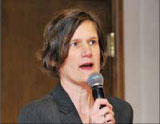 Ellen Batchelor shares tips on lean processing.
Ellen Batchelor shares tips on lean processing.“Lean” is a key word. The concept of lean processing, in brief, means maximizing customer value and minimizing waste, explained Ellen Batchelor, a health care quality improvement coach with Zeroth Blue and project manager with the Colorado Foundation for Medical Care. The customer is the recipient of the process. Value is something the customer wants and is willing to pay for, whether monetarily, with time or in another way. And waste is anything that adds cost or time without adding value.
Waste can be found in every process in health care such as errors in billing or clinical work; unnecessary movement of staff or equipment during a processing step; too much or too little inventory; or when patients are waiting for services or staff are waiting for laboratory results.
To “lean a process,” you must define your team and engage your leaders, Batchelor said. “Your team is not your best and brightest; it’s one person from every area of your organization that’s involved in that process. If you’re looking at your patient check-in, you’ll want your front desk person, maybe a billing person, a physician or primary provider, nursing staff and whomever else might be involved with patient check-in.”
The team starts by assessing the process and determining the baseline. Then they diagnose the problem using “lots and lots of data,” she said. Along the way is problem-solving, which in lean involves using solutions tailored to a practice’s specific needs. “We have to remember that problems look a lot alike on the surface but blanket solutions and best practices do not always work, so don’t just take [another practice’s] solution and try it at your office.”
“The next step is to treat. You have your data, you have it figured out, you’ve done some problem-solving and you’re ready to treat the problem. You might do some just-in-time training or workload balancing. There are a lot of tools in lean.”
“Finally, you’re going to prevent. Once you have your process at a point where you think it’s going to work, this is where you really get the mindset of continuous quality improvement. You’re going to have some storyboards, some visual controls, things to keep you on track.”
As a result, “you’re going to have fewer people and things sitting around waiting,” she said. “You’re going to have people working to their highest training. You’re going to have exam rooms that have what they need, when you need it, where you need it.” You’re going to have less motion waste. “You’re going to have people who have organized workspaces and employees who are satisfied because they’re working to their highest capacity. You’re going to have fewer errors. And, we don’t talk about this a lot in medicine, but you’re going to have a higher return on investment.”
Another case study: Five levels of the virtual PCMH
 Dale Glenn, MD, talks on how to build a virtual patient-centered medical home.
Dale Glenn, MD, talks on how to build a virtual patient-centered medical home.Dale Glenn, MD, chief of family medicine and medical director of information systems for Straub Clinic and Hospital in Honolulu, took five steps to build a virtual patient-centered medical home, “virtual” because members of the full care team don’t have to be present in the clinic and can serve multiple sites. Visually, the steps are represented in a pyramid with information systems as the base. “The first thing you absolutely must have is data. The new model of health care is based on information.”
“Then you’ve got to go to the next layer, shared clinical protocols. This can be tough,” Glenn said. “You have to do this rule by rule and layer by layer, at least agreeing within your practice that you’re all going to try to standardize a lot of your care because this will dramatically improve the quality you give your patients.”
The next level, reporting and incentives, tracks the progress of transformation and rewards improvement. “Ideally you want your payment to be tied to that. The new payment system is really important; you can’t fund a lot of these changes under fee-for-service medicine.”
“The next layer we went to was team care. Quality is a team sport. The idea of a single person being solely responsible for another human being’s health in this complex day and age is ridiculous. It doesn’t mean you can’t be a solo practitioner; you can be financially independent. But we need to be more interdependent and that’s why organizations like [the Colorado Medical Society] are so important.”
And those four steps lead to the most important, on the top of the pyramid: “the true patient-centered approach to health care.”
Team-based care
As Glenn and nearly all other Spring Conference speakers mentioned, team-based care is essential for practice transformation. They recommend allocating tasks among the various health care providers so each professional is working “to the top of his or her license” and in a collaborative manner. But employing this concept isn’t always easy.
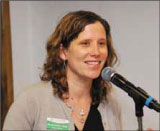 Nicole Deaner, MSW, discusses being an effective leader.
Nicole Deaner, MSW, discusses being an effective leader.“It’s a fairly big culture change to empower teams and move toward a team-based care model,” said Nicole Deaner, MSW, program manager at HealthTeamWorks. “In a lot of senses, many practices have been very traditional or hierarchical in how they practice, and in this new world of patient-centered medical homes and medical neighborhoods, we have to move much more toward a team-based approach.”
It requires engaging the whole team and empowering individuals to work at their highest level. “When you look at the roles within a practice, often people can expand much more than what they’re doing now. And you want to think about staff not only within their roles but as their individual skills and talents.”
Glenn said “we practice the science of medicine in teams so we can practice the art of medicine as individuals. The main focus of this transformation is so that you can spend more quality time with your patients. Not doing paperwork, not being on the computer, not doing faxes and things back and forth.”
“The standard model for thousands of years was the provider and the patient,” he continued. “Because medicine was getting more and more complex, we added nurses and MAs to help do some of the work. It’s gotten even more complex so we needed even more help. We added care coordinators. We’ve added nurse educators; they’re a critical part of our team. Now we have nurse case managers; they help us with hospital transitions and help prevent readmissions.”
The allied health professionals in Glenn’s practice have lists of protocols they must address before the physician enters the exam room. “Save the critical thinking for the things that really matter: Making the difficult diagnosis, understanding those complex systems, really taking a good history like you learned in school.”
And once they examined quality reports comparing all physicians on a variety of metrics, they revealed that the highest scorers were the ones who embrace team care. “The doctors who are doing well are the ones who are using their staff. This is the transformation that we have to help physicians make if we’re going to get to team care.”
But Glenn stressed that each team member must work under the physician’s authority and have the trust and permission of the physician to act on his or her behalf. “You have to have protocols that you both trust so you can let them do their jobs.”
Constructing a medical neighborhood
 Marjie Harbrecht, MD, discusses the benefits of the medical neighborhood.
Marjie Harbrecht, MD, discusses the benefits of the medical neighborhood.A broader application for team-based care is the medical neighborhood. Health care has gotten so complicated that no physician – neither primary care nor specialist – can do it alone and that realization is pushing health care professionals into teams, said Marjie Harbrecht, MD, CEO of HealthTeamWorks. The typical primary care physician deals with 229 other physicians working in 117 practices, and the average Medicare beneficiary sees seven different physicians and fills more than 20 prescriptions per year.
“We went into these various arenas because that’s what we wanted to do. Now we have to figure out how to get the patients to the right place at the right time for the right care, and align everybody so we can all move together toward the best quality, affordable care and best experience.”
Building the medical neighborhood starts with a conversation with patient-centered care at its core, where all providers respect the skills each brings to the table, recognize the value of that differentiation, acknowledge the problem, and remain professional. Together, health care teams must establish a shared community vision, shared care plans and a plan for shared data that allows access to patient information at the point of care, individual outreach for patients needing care and for identifying trends in communities for targeted programs.
Health information technology and interoperability
Physician adoption of electronic health record systems has rapidly increased over the past few years due to funding opportunities from the private and public sector as well as upcoming penalties for those who don’t use their EHR to e-prescribe, produce quality reports or perform other tasks designated as “meaningful use.” Health information exchanges provide the platform for shared data by connecting EHR systems and pushing clinical information back out to providers.
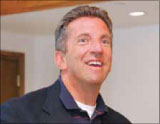 Larry Wolk, MD, shares how CORHIO connects physicians to needed data.
Larry Wolk, MD, shares how CORHIO connects physicians to needed data.Colorado has two Health Information Exchanges (HIE): the Colorado Regional Health Information Organization and Quality Health Network. CORHIO is the state-designated entity for HIE and covers most of the east and south regions: 40 hospitals and more than 1,800 office-based physicians and providers. QHN connects 10 hospitals, more than 800 medical providers and 140 other health care organizations in western Colorado.
CORHIO has two products, one that integrates directly into a practice’s EHR system and a freestanding portal for physicians without an EHR, said Larry Wolk, CORHIO CEO. Both allow access to patients’ community health records at the point of care including test results, hospital admission and discharge alerts, care summaries, transcribed notes, and newborn screening results.
And, particularly important for the medical neighborhood, physicians can make electronic referrals and send and receive information from any provider on the HIE’s network. Specialists can designate how they want referral direction delivered to them and their consultation notes go back to the primary care physician. As communities work to develop medical neighborhoods, they are creating the framework for a safe, effective and efficient system where patients neither fall through the cracks nor receive duplicate services.
A numbers game: metrics reports and population management
Data is imperative in practice transformation. Gathering metrics allows physicians to set benchmarks and goals for process and quality improvement, and demonstrate value to payers and patients who increasingly demand this information.
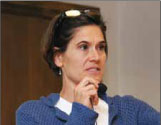 Jane Brock, MD, MSPH, describes the technique of value-stream mapping.
Jane Brock, MD, MSPH, describes the technique of value-stream mapping.While an EHR system may help consolidate large pools of clinical information for data mining, Spring Conference attendees learned a technique to gather information to increase efficiency using a simple stopwatch. Value-stream mapping, a similar method to lean, helps practices “get a metric around chaos,” said Jane Brock, MD, MSPH, chief medical officer for the Colorado Foundation for Medical Care. A practice can map three things: the process, the producer (the person delivering the service), or the product – which in health care could be considered a completed patient visit.
“That’s really the role of value-stream mapping; it is a tool to help you learn in real time. Anytime you’re frustrated you can pull out a stopwatch and get some information. It’s meant to map materials and information required to bring a product or service to a consumer.”
A practice leader might use this as a data-driven way to restructure staff responsibilities “without getting into nastiness or the perception of unfairness,” Brock said. “It certainly empowers staff and maintains buy-in. It allows you to examine outliers; if it’s your perception that you have one physician who is very efficient and one who isn’t, by observing exactly what they do and looking at the proportion of time spent in physician work, you can adjust the schedule accordingly.”
Measuring patient value-added time can also be used as an outcomes tool to validate a particular process change to staff, particularly “if you perceive that change is going to degenerate into finger-pointing about who’s not doing what.” Brock gave the example of wait time, which has been shown to be harmful to the patient.
The best way to capture this data is to give the patients the stopwatch, she said. Tell them at check-in to click the stopwatch anytime something happens: when they are called back to the exam room, when a care provider comes in, when they leave the room. “If you can get patients to capture this data for you one day a month, you can really start to take a look at what works in your practice and what doesn’t.”
The rise of big data and the All Payer Claims Database
Besides tracking metrics for quality and process improvement, physicians also must know their own data to understand how they compare to others in the health care market and be able use this information to leverage their position.
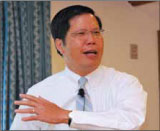 Jay Want, MD, encourages physicians to use data to leverage their market position.
Jay Want, MD, encourages physicians to use data to leverage their market position.This was the message from Jay Want, MD, and Phil Kalin, both from the Center for Improving Value in Health Care – the nonprofit that’s administering the Colorado All Payer Claims Database, or APCD.
Business and organizations already know a large amount of information about individuals and consumers, said Want, CIVHC chief medical officer. “The chances that they’re not going to know huge amounts about you as a doctor? An economist would say that value is statistically indistinguishable from zero.”
“Information has become cheaper than zero,” Want continued. “The challenge today is not that you can’t find the information, the challenge is filtering the information and changing it into something that you can actually do something about.”
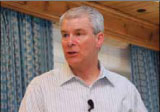 Phil Kalin emphasizes importance of physicians knowing their own data.
Phil Kalin emphasizes importance of physicians knowing their own data.Knowing your own data is going to be key, said Kalin, CIVHC president and CEO. Payment is starting to shift to different mechanisms. Payers are increasingly shifting to the highest-performing practices with narrower networks and providing incentives for providers to send referrals to these high-performers. “It’s only going to increase. The consumers, your patients, are going to know this; businesses are going to have this information. You need to have this information and understand how you are performing relative to your peers.”
Starting in December 2013, CIVHC will make public on www.cohealthdata.org information that shows consumers how various physician practices compare to others on some cost and quality metrics and empowers them to take an active role in the cost of their care. CMS has been actively involved with the APCD since its inception.
For a fee, physicians and other facilities can use the APCD as one place “where you can find a really big data set, draw statistically significant conclusions, and get better,” Want said. “And at the end of the day, we think that’s what binds us all together in this enterprise, which is a promise to get better all the time. We think databases like this give you one component.”
It’s inevitable that information on physician practices will be made public, Kalin said. “All of you are familiar with Healthgrades and Vitals; you’re going to hear about Castlight and iTriage. They’re all getting data from various sources and presenting it for people to see: your patients and other providers who are deciding whether to refer to you or to someone else. So part of the message is about engagement. Better that you’re working with organizations like ours and others to have a chance to see how we’re shaping this because it is going to happen.”
“We’re actually all on the same team,” Want said. “Our vitality now depends on us working on these problems to offer the best health care possible to optimize the state’s future. That’s a really tough message to internalize, but I have to say that working with CMS and with others at our table, they have demonstrated exactly that: an understanding, a belief, a loyalty to the state, which makes us a very special place in the country.”
Broadening health care access
As physicians move forward with practice transformation, they must also look to the horizon and prepare for an influx of patients gaining access to health insurance under the Affordable Care Act.
 Saturday night’s panel experts discuss bridging coverage gaps in Colorado.
Saturday night’s panel experts discuss bridging coverage gaps in Colorado.“The demographics don’t lie,” said Patrick Gordon, associate vice president at Rocky Mountain Health Plans and director of RMHP government programs. “If you look at what’s coming with respect to Medicaid and coverage expansion through the health insurance exchange, hundreds of thousands of people who lack access to coverage are now moving into the system. We need to create the capacity in the system so we can serve that population effectively.”
An estimated 800,000 Coloradans are uninsured. Colorado’s health insurance exchange, Connect for Health Colorado, will open in October 2013 to allow individuals, families and small businesses to find health plans to fit their needs and to find out if they are eligible for federal financial assistance. Coverage through the exchange starts on Jan. 1, 2014. The Colorado Department of Health Care Policy and Financing estimates that the Colorado Medicaid expansion, also effective on Jan. 1, will allow more than 160,000 adults to gain access to health coverage.
Gordon commended Colorado for tackling the challenges of delivery system reform and payment reform while others seem “paralyzed.”
Susan Birch, MBA, BSN, RN, HCPF executive director, said Colorado is ahead because of the collaboration among state agencies, physicians, hospitals and consumer groups. She mentioned the work around service provision, coordinated care, the Regional Care Collaborative Organizations and the children’s medical home program.
“Health care reform is a crazy process,” Birch said. “It’s like flying a jet while we’re rebuilding it from the outside in and keeping it all going.”
“One of the biggest things I would beg you to pass on is that it has taken us decades to get into this situation in the United States and it’s going to take us decades to transform our health care system.” There will be bumps in the road and “we’re really counting on you all to feed that information up to us.”
“What I would ask is that physicians step up and be a part of this change,” Gordon said. “There is no substitute for that leadership. Certainly in Grand Junction when we run into a problem or challenge with respect to any of the aspects of our delivery system, physician leadership is often the key in getting the breakthroughs and making progress.
Shaping the future with innovation
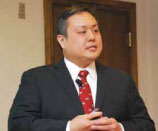 Jason Hwang, MD, MBA, discusses the science behind changes in health care economics.
Jason Hwang, MD, MBA, discusses the science behind changes in health care economics.Continuing to broaden access to health care will mean embracing disruptions to the current model, said Jason Hwang, MD, MBA, an internal medicine physician, senior strategist for an innovation and strategy consulting firm in Massachusetts, and co-author of “The Innovator’s Prescription: A Disruptive Solution to Health Care.” Disruptive innovations – new products or services that improve upon and eventually replace incumbent products – have occurred throughout history and throughout all industries.
He said disruption in health care involves a departure from the general hospital. “This is a business model built on the assumption that if you have a problem, you bring it here and we’ll fix it. All the expertise is here. The problem with that is that this gold standard is not necessarily affordable and accessible, certainly not in areas where you can’t sustain one of these behemoths.” Many people can’t access the system as constructed, the so-called “non-consumers” of health care, because they live too far away, are too poor or lack health insurance.
Physicians must ask whether care delivered in hospitals might be better suited in an outpatient facility, an individual office or “better yet, a kiosk, retail setting or at the patient’s worksite.”
“But it’s not just about the venue, it’s about transferring skills. Whereas the general hospital is dependent on a lot of expensive experts trying to work together, can we take some of their skills, put them in a piece of software, a device or a training program and transfer them to an individual practitioner? Not just a physician, but perhaps a nurse practitioner, a physician assistant, pharmacist, or any of the other allied health care professionals who are tremendously underutilized.”
Ultimately “we need to put more and more power in the hands of consumers using technologies that allow this to be done safely. That’s the only way we can transfer our health care system into a setting that’s affordable and accessible to everyone.” Diagnostic tests must be easily interpreted and medications to treat these conditions must be made available over-the-counter safely or behind the counter “so you can really treat disease effectively as a public health problem.”
We often stand in the way of disruption, whether inadvertently or on purpose, Hwang said. “This is no different from what we see whenever an incumbent is disrupted by a disruptive force. When disruption comes up from the bottom oftentimes the immediate reaction is to deride the quality and safety of the disruptive force.”
Physicians can refuse to empower health care teams, embrace patient-centered technology, or implement new workflows, or they can agree to be the best provider of health care where they are needed most and allow other safe and effective innovations to come in.
“We want to help make sure disruption is a good thing,” Hwang said. “It is good for our patients, it’s been slowly coming to health care and I think with all your help and support, we can make it happen.”